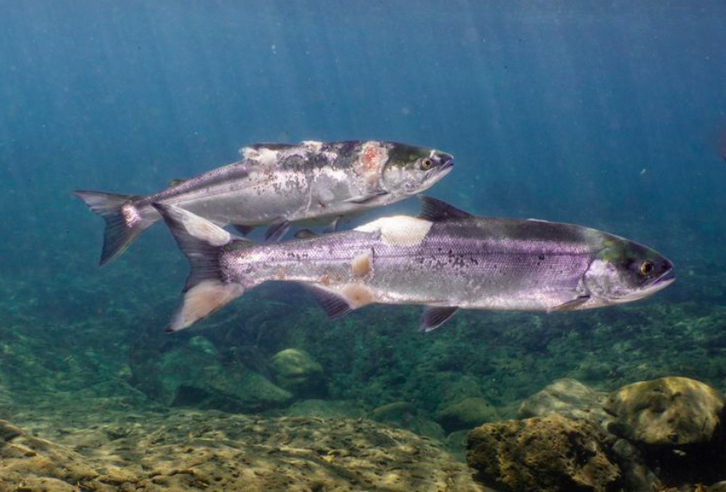forum
library
tutorial
contact

Snake River Dams
in Hot Water
by Brett VandenHeuvel & Jeremiah "Jay" Julius
Seattle Times, June 29, 2020
|
the film forum library tutorial contact |

|
Snake River Dams
by Brett VandenHeuvel & Jeremiah "Jay" Julius
|
Video taken over the summer showed sockeye salmon covered in lesions and fungus -- the result of water that was 71 degrees.
 Thousands of salmon are now undertaking the final leg of their incredible migration, struggling to return to the streams of their birth. From the Salish Sea to the mountains of Idaho, these fish connect, sustain and define the Pacific Northwest. Unless we can restore the Columbia and Snake rivers' salmon runs, we stand to lose the southern resident orcas and the fisheries that the tribes and people of the Pacific Northwest rely upon.
Thousands of salmon are now undertaking the final leg of their incredible migration, struggling to return to the streams of their birth. From the Salish Sea to the mountains of Idaho, these fish connect, sustain and define the Pacific Northwest. Unless we can restore the Columbia and Snake rivers' salmon runs, we stand to lose the southern resident orcas and the fisheries that the tribes and people of the Pacific Northwest rely upon.
Salmon confront many obstacles, but one of the most dangerous is invisible: rising river temperatures. The shallow, slow-moving reservoir currents on the Lower Snake River soak up and store the sun's heat. Salmon suffer at temperatures above 68 degrees Fahrenheit, and relentless heat can be deadly; in 2015, hot water killed 250,000 adult sockeye salmon in the Columbia and Snake rivers.
The loss is devastating. Indigenous peoples of our region once lived in communion with the natural world. The rivers teemed with salmon, and orcas thrived. There was an interdependence between the people, the wildlife and the place. But changes came with the advent of technology. We were told that technology held the promise of saving our region and creating a new and better future. What we've found in some cases is that our man-made solutions have created man-made problems, causing extreme disruptions to waters and habitat.
An Environmental Protection Agency report confirms that the main cause of hot water in the Columbia Basin -- especially in the Lower Snake River -- is the dams. On average, the Lower Snake River reached temperatures unsafe for salmon 68 days a year.
Meanwhile, Washington and Oregon recently exerted their legal authority to require eight federal dams on the Columbia and Lower Snake rivers to maintain a temperature that is safe for salmon. What does this mean? Suddenly, the Lower Snake River dams themselves are in hot water.
Historically, the U.S. Army Corps of Engineers largely ignored the Lower Snake River dams' heat pollution. Now, Washington and Oregon's action to enforce temperature limits creates serious consequences for the hydropower facilities. This marks a tipping point for the future of salmon and our way of life.
To reduce river temperature, the Army Corps must make major changes to its management of the Lower Snake River dams. Located in one of the hottest parts of Washington, these four dams are the worst temperature offenders with some of the least flexibility when it comes to their operation. Big, bold changes will be required. The case for Lower Snake River dam removal is stronger than ever.
These dams stand between the ocean and some of the best remaining spawning habitat for salmon and steelhead. They also stand between the Pacific Northwest and a future with strong salmon runs, sustainable fishing cultures and orcas. We've spent billions trying to reverse the trend toward extinction with these dams in place. But the Lower Snake River dams, once sold as a symbol of American progress and ingenuity, have proven detrimental to our salmon populations.
Addressing the temperature crisis will take more than scientific studies or court decisions. The future of salmon, tribal and sustainable fisheries, orcas, river communities, and clean and affordable power in our region all depend on the ability of Northwest elected leaders, sovereign nations and communities to come together and solve these challenges. It's also time to rethink the idea of technology as the answer to all problems and consider a free-flowing Snake River where teeming runs of salmon migrate from river to sea and back again, and our waters have enough fish for orcas and people to thrive.
learn more on topics covered in the film
see the video
read the script
learn the songs
discussion forum
